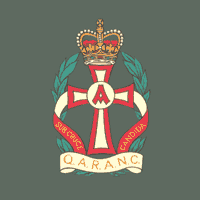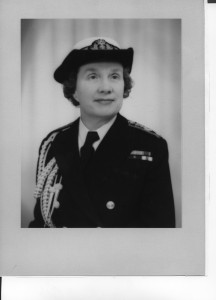
The Women's Royal Naval Service was the women's branch of the United Kingdom's Royal Navy. First formed in 1917 for the First World War, it was disbanded in 1919, then revived in 1939 at the beginning of the Second World War, remaining active until integrated into the Royal Navy in 1993. WRNS included cooks, clerks, wireless telegraphists, radar plotters, weapons analysts, range assessors, electricians and air mechanics.

Queen Alexandra's Royal Army Nursing Corps is the nursing branch of the British Army Medical Services.

These are the official Royal Navy Officer ranks ordered by rank. These ranks are part of the NATO/United Kingdom ranks, including modern and past. Past insignia is in italic.
The Royal Australian Naval Nursing Service (RANNS) was a former female branch of the Royal Australian Navy.

The Royal Hospital Haslar in Gosport, Hampshire, which was also known as the Royal Naval Hospital Haslar, was one of Britain's leading Royal Naval Hospitals for over 250 years. Built in the 1740s, it was reputedly the largest hospital in the world when it opened, and the largest brick-built building in Europe.

Dame Doris Winifred Beale, was a British military nurse and nursing administrator who served as Matron-in-Chief of Queen Alexandra's Royal Naval Nursing Service from 1941 to 1944 during the Second World War. In the 1944 Birthday Honours she was appointed Dame Commander of the Order of the British Empire (DBE), a first in the Royal Naval Nursing Service.
The 1947 New Year Honours were appointments by many of the Commonwealth Realms of King George VI to various orders and honours to reward and highlight good works by citizens of those countries. They were published on 31 December 1946.
The 1946 New Year Honours were appointments by many of the Commonwealth Realms of King George VI to various orders and honours to reward and highlight good works by citizens of those countries, and to celebrate the passing of 1945 and the beginning of 1946. They were announced on 1 January 1946 for the United Kingdom, and Dominions, Canada, the Union of South Africa, and New Zealand.
The King's Birthday Honours 1942 were appointments by King George VI to various orders and honours to reward and highlight good works by members of the British Empire. They were published on 5 June 1942 for the United Kingdom and Canada.
The 1946 King's Birthday Honours, celebrating the official birthday of King George VI, were announced on 13 June 1946 for the United Kingdom and British Empire.
The King's Birthday Honours 1945, celebrating the official birthday of King George VI, were announced on 14 June 1945 for the United Kingdom and British Empire.
The 1944 King's Birthday Honours, celebrating the official birthday of King George VI, were announced on 2 June 1944 for the United Kingdom and British Empire, New Zealand, and South Africa.
The King's Birthday Honours 1943 were appointments by King George VI to various orders and honours to reward and highlight good works by people of the British Empire. They were published on 2 June 1943 for the United Kingdom and Canada.
The 1917 New Year Honours were appointments by King George V to various orders and honours to reward and highlight good works by citizens of the British Empire. The appointments were published in several editions of The London Gazette in January and February.
The 1919 New Year Honours were appointments by King George V to various orders and honours to reward and highlight good works by citizens of the British Empire. The appointments were published in The London Gazette and The Times in January 1919.

Cynthia Felicity Joan Cooke, was a British military nurse and nursing administrator who served as Matron-in-Chief of the Queen Alexandra's Royal Naval Nursing Service, the nursing branch of the Her Majesty's Naval Service, from 1973 to 1976.

Commodore Inga Jane Kennedy, is a Scottish nurse and retired senior Royal Navy officer. From 2017 to 2021, she served as Head of the Royal Navy Medical Service and Medical Director General (Naval). She was the most senior female officer in the Royal Navy by year of promotion. She previously served as Matron-in-Chief of the Queen Alexandra's Royal Naval Nursing Service (2011–2015) and Inspector General of the Defence Medical Services (2015–2017).
This is a timeline of women in the Indian military and Coast Guard.

Annie Ina Laidlaw was an Australian nursing matron who led the Royal Australian Naval Nursing Service during the Second World War.
Eliza Mackenzie was a Scottish superintendent of nurses with the Navy during the Crimean War. Her brief career led to the formation of the Queen Alexandra's Royal Naval Nursing Service (QARNNS) in 1902.













